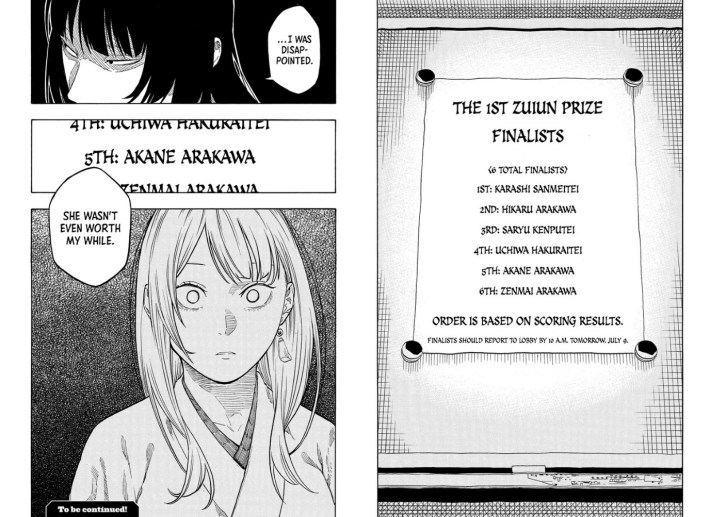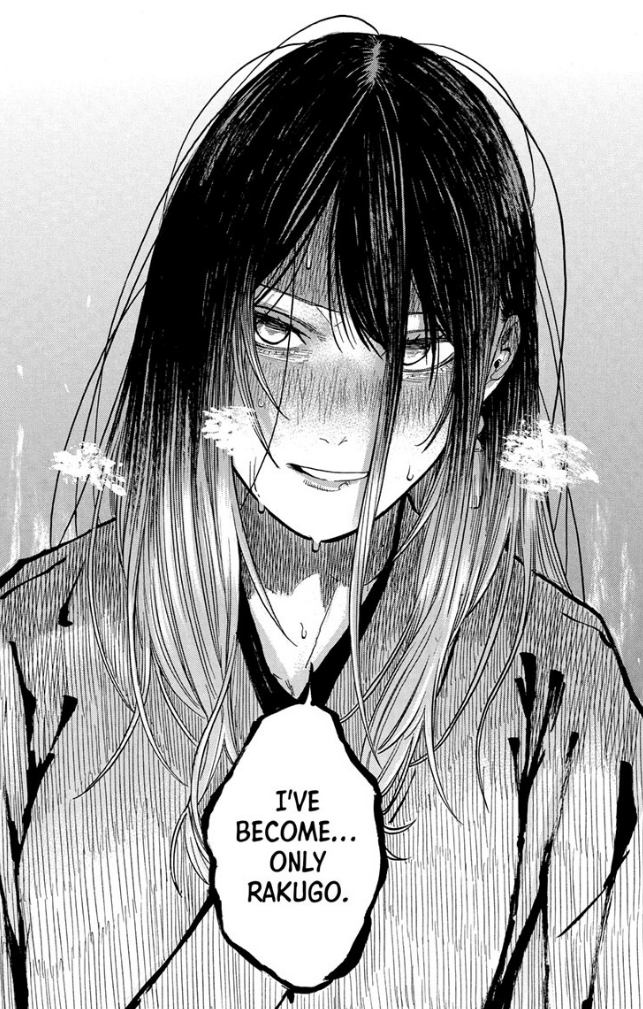For years, I treated Akane-banashi like a dessert, saving the chapters for last every Sunday as the highlight of my Weekly Shonen Jump lineup. Then I got greedy. I stopped reading—not out of disinterest, but to stockpile chapters and indulge later. With the announcement of an upcoming anime adaptation, I broke my moratorium, expecting to see my girl shine once more in her series. Instead, I returned to find my best girl fighting for her life in a bold deviation of shonen tropes that only further cements the manga’s growing legacy as a truly remarkable work.
The best kind of manga can focus its stories on a niche interest and elevate it into compelling storytelling through strong writing and a genuine appreciation for its subject. Akane-banashi is the top modern example of this. The ongoing series, which started in 2022 by writer Yuki Suenaga and illustrator Takamasa Moue, is a performance art drama. The story follows Akane Osaki, a teenager who aspires to make a career in rakugo. In this traditional Japanese solo performance art form, an artist portrays multiple characters using only their voice, gestures, and a fan to bring the story to life. Driven by a love for the art form and a desire to uncover why her father was famously banished from it, Akane works to become an accomplished rakugoka.
Although Akane-banashi might not seem like typical shonen at first glance—especially to those who assume “girl on cover” indicates a shoujo vibe—the manga is, at its core, a masterful example of shonen storytelling. Akane’s journey to redeem her disgraced father is more than just a personal mission; it immerses her in the rakugo world, a hierarchy resembling the Demon Slayer corps or a Yakuza organization. Performers take on surnames as inherited symbols of renowned rakugo lineages and compete for prestige in intense tournament arcs, ultimately facing the art form’s heavenly kings, who judge whether they can advance further. One such top king is Issho Arakawa, the man who expelled Akane’s father. It’s his looming presence that fuels Akane’s unyielding rise.
It’s not just me and former Kotaku writer Sisi Jiang who sing praises for the series. Akane-banashi has motion in manga and anime circles, with creatives like One Piece’s Eiichiro Oda and Evangelion’s Hideaki Anno recommending the series to their fans. However, the series’ latest developments, which subvert typical shonen tropes, have only made it all the more engrossing to read.
So spoilers for that.
Much like how Naruto Shippuden reintroduced its orange knuckled-headed ninja with a time-skip and a sharpened resolve, Akane-banashi delivers a similar grand return. After an excursion overseas honing her craft in France, Akane returns to Japan—not as the bright-eyed ingénue we first met, but as a rakugo contender equipped with new techniques and a sharpened fire, all while carrying the quiet burden of fulfilling what her father couldn't. However, she’s no longer the talk of the town. Rakugo is a brutal “what-have-you-done-for-me-lately” stage, and the early chapters show her struggling under the pressure to regain her reputation, rhythm, and relevance.
I put the series aside for a couple of months, thinking Akane-banashi might stick to familiar beats—rivalries picking back up, theatrical power shifts in rankings, and Akane climbing the ladder as usual. But when I checked back in, I saw my manga daughter in the trenches.

Akane’s comeback arrived with drama worthy of a shonen resurgence. She throws down the gauntlet against Karashi Nerimaya—the volatile “problem child” of rakuga—and Hikaru Koragi, the ragkugo world’s voice actor idol. These two, part of Akane-banashi’s in-universe Big Three, owe their rise to the bar Akane once set, pushing them to their limits to chase her rising star. When they compete in a tournament, Akane doesn’t just lose to them as the third-best in their trio; her performance sees her slide even further down the rakugo rankings, ranking fifth for the day. My GOAT is washed.
However, instead of celebrating their victory, Hikaru and Karashi confront Akane with a colder expression: disappointment. They don’t desire a hollow rival—they want her at her best self. The performer who once had the audience roaring is gone, replaced by this version filtered through the stern lens of her toxic new mentor, Issho, who forces her to perform without making audiences laugh (her signature rakugo style). She tried to fix this with an unconventional medley performance blending genres that, while impressive, didn’t wow audiences or judges like Hikaru and Karashi—two rakugokas who’ve become household names in Akane’s absence.
The manga’s brilliance lies in how it turns this niche theater tradition into a narrative engine. Its performers dissect each other’s creative choices, tweak genres, and chase emotionally cathartic payoffs to their tales. But they’re not just telling stories—they’re rewriting the rules of rakugo to get to their emotional climax.
And then there’s Akane, my manga daughter. She doesn’t walk back into this world to cheers. She reenters the rakugo world to scrutiny, doubt, and whispered what-happened-to-her’s as a has-been rakugoka instead of a returning star. It’s a reversal of the classic shonen hero’s homecoming. But instead of deflating her arc, it electrifies it.

Just when I felt an immense guilt for abandoning my girl in her time of need, Akane appears to have tapped into rakugo’s version of ultra instinct, declaring, “I’ve become only rakugo.” It’s a declaration that made me feel like the manga is teasing one of the most imposing comeback shonen victories for Akane in its ongoing tournament arc to rival that of a Saiyan’s zenkai boost.
Akane-banashi doesn’t just dramatize rakugo, it weaponizes it. Each character refines their delivery like a fighter adjusting their style through off-screen training or mid-performance improvisation, blending comedic, romantic, and dramatic styles to redefine what a solo performance can feel like. Whether it be its cast of comedians, actors, or wild-card upstarts, witnessing them morph their performances into slapstick routines, psychological thrillers, or heart-tugging romance—all while locked in a quiet rivalry to be crowned the new rakugoka legend makes Akane-banashi my favorite read on Shonen Jump.
Watching Akane reclaim her space in a medium that lives and dies by audience response, pushing against etiquette and expectation, is nothing short of exhilarating. If Shonen Jump, like rakugo, is a stage where only one voice rules the room, Akane-banashi holds the floor every week. More folks should get in on the ground floor before it becomes passé to say you liked it before it became an anime.


